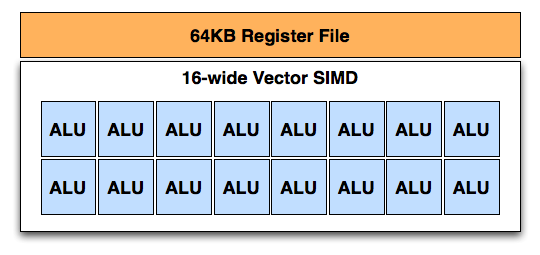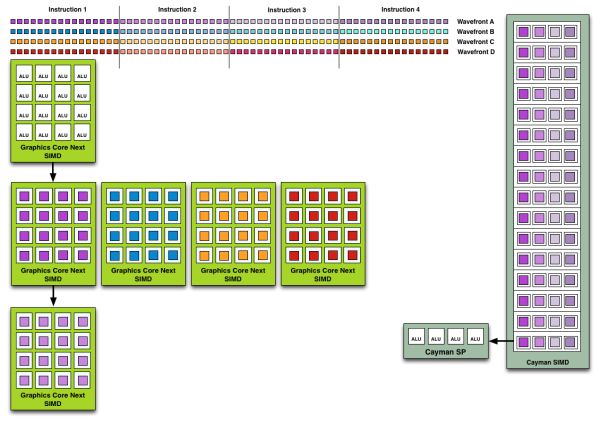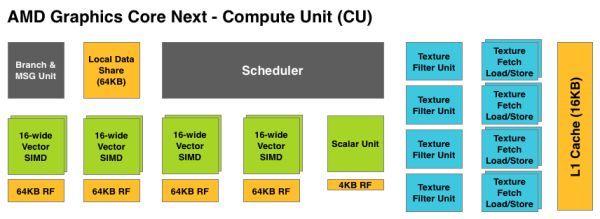AMD Radeon HD 7970 Review: 28nm And Graphics Core Next, Together As One
by Ryan Smith on December 22, 2011 12:00 AM EST- Posted in
- GPUs
- AMD
- Radeon
- ATI
- Radeon HD 7000
A Quick Refresher, Cont
Having established what’s bad about VLIW as a compute architecture, let’s discuss what makes a good compute architecture. The most fundamental aspect of compute is that developers want stable and predictable performance, something that VLIW didn’t lend itself to because it was dependency limited. Architectures that can’t work around dependencies will see their performance vary due to those dependencies. Consequently, if you want an architecture with stable performance that’s going to be good for compute workloads then you want an architecture that isn’t impacted by dependencies.
Ultimately dependencies and ILP go hand-in-hand. If you can extract ILP from a workload, then your architecture is by definition bursty. An architecture that can’t extract ILP may not be able to achieve the same level of peak performance, but it will not burst and hence it will be more consistent. This is the guiding principle behind NVIDIA’s Fermi architecture; GF100/GF110 have no ability to extract ILP, and developers love it for that reason.
So with those design goals in mind, let’s talk GCN.
VLIW is a traditional and well proven design for parallel processing. But it is not the only traditional and well proven design for parallel processing. For GCN AMD will be replacing VLIW with what’s fundamentally a Single Instruction Multiple Data (SIMD) vector architecture (note: technically VLIW is a subset of SIMD, but for the purposes of this refresher we’re considering them to be different).

A Single GCN SIMD
At the most fundamental level AMD is still using simple ALUs, just like Cayman before it. In GCN these ALUs are organized into a single SIMD unit, the smallest unit of work for GCN. A SIMD is composed of 16 of these ALUs, along with a 64KB register file for the SIMDs to keep data in.
Above the individual SIMD we have a Compute Unit, the smallest fully independent functional unit. A CU is composed of 4 SIMD units, a hardware scheduler, a branch unit, L1 cache, a local date share, 4 texture units (each with 4 texture fetch load/store units), and a special scalar unit. The scalar unit is responsible for all of the arithmetic operations the simple ALUs can’t do or won’t do efficiently, such as conditional statements (if/then) and transcendental operations.
Because the smallest unit of work is the SIMD and a CU has 4 SIMDs, a CU works on 4 different wavefronts at once. As wavefronts are still 64 operations wide, each cycle a SIMD will complete ¼ of the operations on their respective wavefront, and after 4 cycles the current instruction for the active wavefront is completed.
Cayman by comparison would attempt to execute multiple instructions from the same wavefront in parallel, rather than executing a single instruction from multiple wavefronts. This is where Cayman got bursty – if the instructions were in any way dependent, Cayman would have to let some of its ALUs go idle. GCN on the other hand does not face this issue, because each SIMD handles single instructions from different wavefronts they are in no way attempting to take advantage of ILP, and their performance will be very consistent.

Wavefront Execution Example: SIMD vs. VLIW. Not To Scale - Wavefront Size 16
There are other aspects of GCN that influence its performance – the scalar unit plays a huge part – but in comparison to Cayman, this is the single biggest difference. By not taking advantage of ILP, but instead taking advantage of Thread Level Parallism (TLP) in the form of executing more wavefronts at once, GCN will be able to deliver high compute performance and to do so consistently.
Bringing this all together, to make a complete GPU a number of these GCN CUs will be combined with the rest of the parts we’re accustomed to seeing on a GPU. A frontend is responsible for feeding the GPU, as it contains both the command processors (ACEs) responsible for feeding the CUs and the geometry engines responsible for geometry setup. Meanwhile coming after the CUs will be the ROPs that handle the actual render operations, the L2 cache, the memory controllers, and the various fixed function controllers such as the display controllers, PCIe bus controllers, Universal Video Decoder, and Video Codec Engine.
At the end of the day if AMD has done their homework GCN should significantly improve compute performance relative to VLIW4 while gaming performance should be just as good. Gaming shader operations will execute across the CUs in a much different manner than they did across VLIW, but they should do so at a similar speed. And for games that use compute shaders, they should directly benefit from the compute improvements. It’s by building out a GPU in this manner that AMD can make an architecture that’s significantly better at compute without sacrificing gaming performance, and this is why the resulting GCN architecture is balanced for both compute and graphics.












292 Comments
View All Comments
tw99 - Thursday, December 22, 2011 - link
I just wanted to say thank you for including the 8800 GT in some of your benchmark charts. Even though its dated hardware, including it in your comparisons illustrates the punch that the newer hardware has and assists in decision making for people like myself looking to upgrade from their current setup, unlike most benchmarking articles on other sites that like to compare only the very recent generations, not taking consideration what people would have now.Leyawiin - Thursday, December 22, 2011 - link
I wonder if the Arctic Cooling Twin Turbo II I have sitting in the closet (and haven't ever used) would fit on one of these? Its compatible for up to an HD 6970 so I know it can cool one of these sufficiently (if the mounting holes match their old cards). Maybe I should wait to see what the HD 7950 is like - buying the top of the line card at launch usually isn't smart from a value standpoint.Leyawiin - Thursday, December 22, 2011 - link
Its all a moot point anyway. Damn "soft launch" not available for at least three weeks. Just a marketing ploy to keep people from buying Nvidia's top cards at the moment. If you aren't ready to sell your cards, keep your mouth shut.james.jwb - Thursday, December 22, 2011 - link
I have an Arctic Cooling Extreme Plus II on a 6970 and wouldn't use the lower sized versions. But Im also interest to know if it'll fit the 7970. But in all honesty, until these prices come down I won't go near this card, the performance increases just aren't worth it for most people.Dark Man - Thursday, December 22, 2011 - link
It looks like page 7 and 8 got the same content ?Dark Man - Thursday, December 22, 2011 - link
Sorry, page 8 and 9Dark Man - Thursday, December 22, 2011 - link
Page 13 and 14, tooRyan Smith - Thursday, December 22, 2011 - link
We added a couple of pages this morning; you're probably seeing the cascade effect of the rest of the pages being pushed back.evilspoons - Thursday, December 22, 2011 - link
I'd just like to say that I found this review harder to read than the usual stuff on Anandtech. Everything seemed wordy - if there was an opportunity to use a sentence instead of a word, the sentence was used.Good job on the comprehensive information, but trim the fat off the writing next time, please!
RussianSensation - Thursday, December 22, 2011 - link
Even if it's a 6 months lead, 2012 is so far looking like a year full of console ports. We have Syndicate (February 21, 2012), then Mass Effect 3, Max Payne 3 (both on March 6). Those games will get crushed by modern GPUs. HD7970 is an amazing buy for those who are building a new system now/soon and planned to spend $500+ on a GPU. But for current GPU owners, it's not enough of a performance boost imho. And on its own, it's still not fast enough for 2560x1600 either. It's a good card, but since modern GPU generations last 18-24 months, it's too early to call it great.